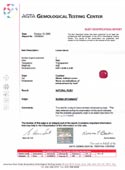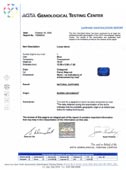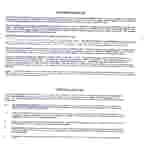Colored Gem Certificates
Rubies, sapphires, emeralds and other colored stones are a much more complicated world than diamonds. They are more difficult to judge and classify, and colored stones certificates tend to fall short. While a Diamond Report from a respected lab such as GIA is a useful adjunct to an appraisal, colored stone reports are, in general, much less so.
For some colored stones, the origin — the location where it was mined – greatly affects the value of the gem. For example, an untreated ruby from Burma is worth far more than a similar one mined somewhere else; an untreated sapphire from Kashmir is far more valuable than a similar one from elsewhere. The major grading labs have the equipment and expertise to determine origin, and a certificate from one of these labs, stating where such a gem was mined, is essential in substantiating the gem’s value.
AGTA Identification Report
This is the colored stone report we recommend. The American Gem Trade Association gives shape, measurements, weight and determination as to whether the stone is natural or synthetic. It includes a photo. In our example, the report also mentions that the examined stone was loose (determinations are more likely to be accurate when a stone is examined loose rather than in a setting). Certificates will vary somewhat depending on the stone type (i.e., ruby v. sapphire).
| American Gem Trade Association Ruby Certificate | ||
| AGTA
Ruby |
|
AGTA
Ruby |
|
|
||
| AGTA
Sapphire |
AGTA
Sapphire |
|
In reporting that a stone was not heat-enhanced, the report adds the comment that it is rare for a ruby/sapphire to not be enhanced by heat. This lack of heat treatment adds value to the stone. AGTA also gives the geographical origin of the ruby, which can affect value. A chart at the bottom of the report shows the tests carried out in the examination of this gem.
However, as to color, AGTA gives the ruby’s hue only as red, the sapphire’s hue only as blue. These are vague (especially since all rubies are by definition red). The report does not use one of the specific hues from the GIA scale, does not give tone or saturation at all, and does not mention clarity. (See Color for the specific terms used to accurately describe hue, tone and saturation of colored gem.) Basically, the color grading on the certificate is worthless!
GIA Identification Report
The Gemological Institute of America’s report gives shape, measurements, and weight. It mentions whether the stone is natural or synthetic and whether the color is natural. It may also indicate whether the gem has been subjected to treatments. It does not mention clarity. As to color, it gives only hue. It does not give tone and saturation. Here, again, the grading for color is worthless.
| GIA Gem Trade Laboratory Identification Report | ||
| GIA Gem
Trade |
GIA
Gem Trade |
|
 Buyer’s
Tip
Buyer’s
Tip
A colored stone certificate is not a substitute for an Appraisal.






